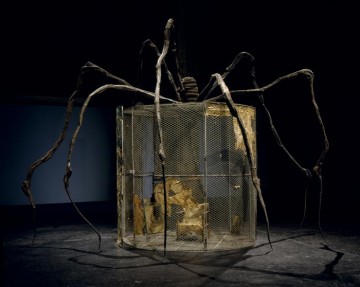
The Grande Dame of Surrealism has her first major Retrospective in the United States-Louise Bourgeois at the Museum of Contemporary Art in Los Angeles by Sharon Anderson
Published in the Northside San Francisco Newspaper in Dec. 2008
My childhood has never lost its magic, it has never lost its mystery, and it has never lost its drama. —Louise Bourgeois
On Christmas Day in 1911, Louise Bourgeois was born in Paris, France. Raised by parents who sold and repaired tapestries by trade, she became aware of art at an early age. She studied mathematics at the Sorbonne, which fueled her early interest in cubism. Now, as she nears her 97th year, Louise Bourgeois is still making relevant work and is the last remaining artist from the Surrealist Movement, although the association means little to her.
Other Surrealist painters such as Yves Tanguy received acclaim for what is known as Biomorphic Surrealism, an abstract branch on the Surrealist tree featuring unidentifiable images that somewhat resemble organic forms. Although she has been an artist her entire life, Bourgeois did not receive wide acclaim for her similarly soft and flesh like sculptures until she was in her fifties.
Another trait she shares with her Surrealist counterparts is her use of memory, particularly childhood memories as they relate to her family. Psychoanalysis was a strong influence among the Surrealists, and Bourgeois does not shy away from difficult subject matter. Erotic and sexual imagery are consistent themes in her work as are themes relating to relationships. Bourgeois’ father brought his mistress into their home to be young Louise’s governess, and her mother pretended not to notice. The anger and betrayal Bourgeois felt in this situation has echoed throughout her entire career in her works, particularly in the works known as the “Cells”. These are areas concealed by wire or rustic wooden doors through which the viewer, as a voyeur, peers in from the outside. Contorted human forms and erotic organic shapes sit silently among found objects, appearing to tell a story. The viewer, tellingly, is unable to see the entire scene.
This retrospective also includes her early paintings and drawings as well as her vertical sculptures called “Personages”. These consist of wood, bronze and stone stacked to give the impression of an anthropomorphic presence. This exhibit was at the Guggenheim museum in New York City before it came to Los Angeles, and the Personages stood in a row on the Frank Lloyd Wright ramp, giving the sculptures a very ordered and almost militaristic intensity. In Los Angeles, however, these same sculptures were placed together at random intervals in a room, changing the dynamic and giving the impression of people socializing at a cocktail party.
In recent years, Bourgeois has become known for making large bronze sculptures of spiders. One such sculpture is featured in this retrospective. “Spider”, from 1997, is an enormous bronze sculpture of a menacing spider poised over a wire cage. This giant metal object appears lightly poised in space, almost floating, adding to the dreamlike quality of the work.
Viewing these works, it’s easy to imagine young Louise helping her parents drawing the missing segments of the tapestries and assisting in the repair of fabrics. Throughout her career, Bourgeois’ art has exposed what was concealed in her own life. Missing segments, the unspoken and the unseen, the silence between musical notes- these are the landscapes that Louise Bourgeois occupies with honesty and originality.